
Elements of the supernatural and the fantastic were an element of literature from its beginning, though the idea of a distinct genre, in the modern sense, is less than two centuries old.

Elements of the supernatural and the fantastic were an element of literature from its beginning, though the idea of a distinct genre, in the modern sense, is less than two centuries old.
The Epic of Gilgamesh was written over generations following the supposed reign of King Gilgamesh, and is seen as a mythologized version of his life. This figure is sometimes an influence and, more rarely, a figure in modern fantasy. [1]
The Vedic civilization situated around the Indus river valley has a long tradition of fantastical stories and characters, dating back to Vedic mythology. Several modern fantasy works such as RG Veda draw on the Rig-Veda as a source. Brahman folklore was an evolution of the earlier Vedic mythology and had many more fantastical stories and characters, particularly in the Indian epics, such as the Mahabharata by Vyasa, and the Ramayana by Valmiki, both of which were influential in Asia. The Panchatantra (Fables of Bidpai) was influential in Europe and the Middle East. It used various animal fables and magical tales to illustrate the central Indian principles of political science. Talking animals endowed with human qualities have now become a staple of modern fantasy. [2]
The Baital Pachisi (Vikram and the Vampire) is a collection of various fantasy tales set within a frame story about an encounter between King Vikramāditya and a Vetala, an early mythical creature resembling a vampire. According to Richard Francis Burton and Isabel Burton, the Baital Pachisi "is the germ which culminated in the Arabian Nights , and which inspired the Golden Ass of Apuleius, Boccacio's Decamerone, the Pentamerone, and all that class of facetious fictitious literature." [3]


Classical mythology is replete with fantastical stories and characters, the best known (and perhaps the most relevant to modern fantasy) being the works of Homer (Greek) and Virgil (Roman). [4]
The contribution of the Greco-Roman world to fantasy is vast and includes: The hero's journey (also the figure of the chosen hero); magic gifts donated to win (including the ring of power as in the Gyges story contained in the Republic of Plato), prophecies (the oracle of Delphi), monsters and creatures (especially Dragons), magicians and witches with the use of magic.[ citation needed ]
The philosophy of Plato has had great influence on the fantasy genre. In the Christian Platonic tradition, the reality of other worlds, and an overarching structure of great metaphysical and moral importance, has lent substance to the fantasy worlds of modern works. [5] The world of magic is largely connected with the Roman Greek world. With Empedocles, the elements, they are often used in fantasy works as personifications of the forces of nature. [6] Concerns other than magic include the use of a mysterious tool endowed with special powers (the wand); the use of a rare magical herb; and a divine figure that reveals the secret of the magical act.[ citation needed ]
Myths especially important for fantasy include: The myth of Titans; the Gods of Olympus; Pan; Theseus, the hero who killed the Minotaur (with the labyrinth); Perseus, the hero who killed Medusa ( with the gift of magic objects and weapons); Heracles is probably the best known Greek hero; Achilles; the riddling Sphinx; Odysseus; Ajax; Jason (of the Argonauts); Female sorcerers as well Circe, Calypso and goddess Hecate; Daedalus and Icarus.[ citation needed ]
The figures of Chinese dragons were influential on the modern fantasy use of the dragon, tempering the greedy, thoroughly evil, even diabolical Western dragon; many modern fantasy dragons are humane and wise.[ citation needed ]
Chinese traditions have been particularly influential in the vein of fantasy known as Chinoiserie, including such writers as Ernest Bramah and Barry Hughart. [7]
Taoist beliefs about neijin and its influence on martial arts have been a major influence on wuxia, a subgenre of the martial arts film that is sometimes fantasy, when the practice of wuxia is used fictitiously to achieve super-human feats, as in Crouching Tiger, Hidden Dragon . [8]
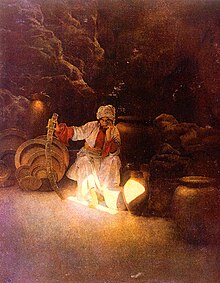
The most well known fiction from the Islamic world was The Book of One Thousand and One Nights (Arabian Nights), which was a compilation of many ancient and medieval folk tales. The epic took form in the tenth century and reached its final form by the fourteenth century; the number and type of tales have varied from one manuscript to another. [9] All Arabian fairy tales were often called "Arabian Nights" when translated into English, regardless of whether they appeared in The Book of One Thousand and One Nights, in any version, and a number of tales are known in Europe as "Arabian Nights" despite existing in no Arabic manuscript. [9]
This epic has been influential in the West since it was translated in the 18th century, first by Antoine Galland. [10] Many imitations were written, especially in France. [11] Various characters from this epic have themselves become cultural icons in Western culture, such as Aladdin, Sinbad and Ali Baba. Part of its popularity may have sprung from the increasing historical and geographical knowledge, so that places of which little was known and so marvels were plausible had to be set further "long ago" or farther "far away"; this is a process that continue, and finally culminate in the fantasy world having little connection, if any, to actual times and places.[ citation needed ]
A number of elements from Persian and Arabian mythology are now common in modern fantasy, such as genies, bahamuts, magic carpets, magic lamps, etc. [11] When L. Frank Baum proposed writing a modern fairy tale that banished stereotypical elements, he included the genie as well as the dwarf and the fairy as stereotypes to go. [12]
The Shahnameh , the national epic of Iran, is a mythical and heroic retelling of Persian history. Amir Arsalan was also a popular mythical Persian story.

Medieval European sources of fantasy occurred primarily in epic poetry and in the Fornaldarsagas, Norse and Icelandic sagas, both of which are based on ancient oral tradition. The influence of these works on the German Romantics, as well as William Morris, and J. R. R. Tolkien means that their influence on later fantasy has been large. [13]
Beowulf is among the best known of the Nordic tales in the English speaking world, and has had deep influence on the fantasy genre; although it was unknown for centuries and so not developed in medieval legend and romance, several fantasy works have retold the tale, such as John Gardner's Grendel . [14]
Norse mythology, as found in the Elder Edda and the Younger Edda, includes such figures as Odin and his fellow Aesir, and dwarves, elves, dragons, and giants. [15] These elements have been directly imported into various fantasy works, and have deeply influenced others, both on their own and through their influence on Nordic sagas, Romanticism, and early fantasy writers.
The Fornaldarsagas, literally tales of times past, or Legendary sagas, occasionally drew upon these older myths for fantastic elements. Such works as Grettis saga carried on that tradition; the heroes often embark on dangerous quests where they fight the forces of evil, dragons, witchkings, barrow-wights, and rescue fair maidens. [16]

More historical sagas, such as Völsunga saga and the Nibelungenlied , feature conflicts over thrones and dynasties that also reflect many motifs commonly found in epic fantasy. [13]
The starting point of the fornaldarsagas' influence on the creation of the Fantasy genre is the publication, in 1825, of the most famous Swedish literary work Frithjof's saga , which was based on the Friðþjófs saga ins frœkna , and it became an instant success in England and Germany. It is said to have been translated twenty-two times into English, twenty times into German, and once at least into every European language, including modern Icelandic in 1866. Their influence on authors, such as J. R. R. Tolkien, William Morris and Poul Anderson and on the subsequent modern fantasy genre is considerable, and can perhaps not be overstated.[ citation needed ]

Celtic folklore and legend has been an inspiration for many fantasy works. The separate folklore of Ireland, Wales, and Scotland has sometimes been used indiscriminately for "Celtic" fantasy, sometimes with great effect; other writers have distinguished to use a single source. [17]
The Welsh tradition has been particularly influential, owing to its connection to King Arthur and its collection in a single work, the epic Mabinogion. [17] One influential retelling of this was the fantasy work of Evangeline Walton: The Island of the Mighty , The Children of Llyr , The Song of Rhiannon , and Prince of Annwn . A notable amount of fiction has been written in the area of Celtic fantasy. [18]
The Irish Ulster Cycle and Fenian Cycle have also been plentifully mined for fantasy. [17]
Scottish tradition is less used, perhaps because of the spurious nature of the Ossian cycle, a nineteenth-century fraud claiming to have much older sources. [17]
Its greatest influence was, however, indirect. Celtic folklore and mythology provided a major source for the Arthurian cycle of chivalric romance: the Matter of Britain. Although the subject matter was heavily reworked by the authors, these romances developed marvels until they became independent of the original folklore and fictional, an important stage in the development of fantasy. [19]
The Finnish epic, the Kalevala, although not published until the 19th century, is compiled from oral tradition dating back to an earlier period. J. R. R. Tolkien cited it, with the Finnish language he learned from it, as a major inspiration behind the Silmarillion. [20]
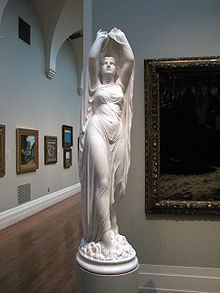
During the Renaissance, Giovanni Francesco Straparola wrote and published The Facetious Nights of Straparola , a collection of stories, many of which are literary fairy tales Giambattista Basile wrote and published the Pentamerone, a collection of literary fairy tales, the first collection of stories to contain solely the stories later to be known as fairy tales. Both of these works includes the oldest recorded form of many well-known (and more obscure) European fairy tales. [21] This was the beginning of a tradition that would both influence the fantasy genre and be incorporated in it, as many works of fairytale fantasy appear to this day. [22]
Although witchcraft and wizardry were both more commonly believed to be actual at the time, such motifs as the fairies in William Shakespeare's A Midsummer Night's Dream , the Weird Sisters in Macbeth and Prospero in The Tempest (or Doctor Faustus in Christopher Marlowe's play) were deeply influential on later works of fantasy.[ citation needed ]
In a work on alchemy in the 16th century, Paracelsus identified four types of beings with the four elements of alchemy: gnomes, earth elementals; undines, water elementals; sylphs, air elementals; and salamanders, fire elementals. [23] Most of these beings are found in folklore as well as alchemy; their names are often used interchangeably with similar beings from folklore. [24]

Literary fairy tales, such as those of Charles Perrault (1628 – 1703), and Madame d'Aulnoy (c.1650 – 1705), became popular early in the Age of Enlightenment. Many of Perrault's tales became fairy tale staples, and influenced latter fantasy as such. Indeed, when Madame d'Aulnoy termed her works contes de fée (fairy tales), she invented the term that is now generally used for the genre, thus distinguishing such tales from those involving no marvels. [25] This would influence later writers, who took up the folk fairy tales in the same manner, in the Romantic era. [26]
Several fantasies aimed at an adult readership were published in 18th century France, including Voltaire's "contes philosophique" "The Princess of Babylon" (1768) and "The White Bull" (1774), and Jacques Cazotte's Faustian novel The Devil in Love . [27]
This era, however, was notably hostile to fantasy. Writers of the new types of fiction such as Defoe, Richardson, and Fielding were realistic in style, and many early realistic works were critical of fantastical elements in fiction. [28] Aside from a few tales of witchcraft and ghost stories, very little fantasy was written during this time. [26] Even children's literature saw little fantasy; it aimed at edifying and deplored fairy tales as lies. [29]
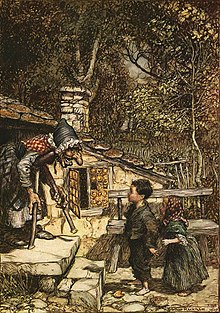
Romanticism, a movement of the late eighteenth and early nineteenth century, was a dramatic reaction to Rationalism, challenging the priority of reason and promoting the importance of imagination and spirituality. Its success in rehabilitating imagination was of fundamental importance to the evolution of fantasy, and its interest in medieval romances providing many motifs to modern fantasy. [30]
In the later part of the Romantic tradition, in reaction to the spirit of the Enlightenment, folklorists collected folktales, epic poems, and ballads, and brought them out in printed form. The Brothers Grimm were inspired in their collection, Grimm's Fairy Tales , by the movement of German Romanticism. Many other collectors were inspired by the Grimms and the similar sentiments. Frequently their motives stemmed not merely from Romanticism, but from Romantic nationalism, in that many were inspired to save their own country's folklore: sometimes, as in the Kalevala , they compiled existing folklore into an epic to match other nation's; sometimes, as in Ossian , they fabricated folklore that should have been there. These works, whether fairy tale, ballads, or folk epics, were a major source for later fantasy works. [31]
Despite the nationalistic elements confusing the collections, this movement not only preserved many instances of the folktales that involved magic and other fantastical elements, it provided a major source for later fantasy. [32] Indeed, the literary fairy tale developed so smoothly into fantasy that many later works (such as Max Beerbohm's The Happy Hypocrite and George MacDonald's Phantastes ) that would now be called fantasies were called fairy tales at the time they written. [33] J. R. R. Tolkien's seminal essay on fantasy writing was titled "On Fairy Stories."
Ossian and the ballads also provided an influence to fantasy indirectly, through their influence on Sir Walter Scott, who began the genre of historical fiction. [34] Very few of his works contain fantastic elements; in most, the appearance of such is explained away, [35] but in its themes of adventure in a strange society, this led to the adventures set in foreign lands, by H. Rider Haggard and Edgar Rice Burroughs, [36] Although Burrough's works fall in the area of science fiction because of their (often thin) justifications for their marvels, [37] Haggard's included many fantastic elements. [38] The works of Alexandre Dumas, père, romantic historical fiction, contained many fantasy tropes in their realistic settings. [39] All of these authors influenced fantasy for the plots, characters and landscapes used—particularly in the sword and sorcery genre, with such writers as Robert E. Howard. [40]
High fantasy, or epic fantasy, is a subgenre of fantasy defined by the epic nature of its setting or by the epic stature of its characters, themes, or plot. High fantasy is set in an alternative, fictional ("secondary") world, rather than the "real" or "primary" world. This secondary world is usually internally consistent, but its rules differ from those of the primary world. By contrast, low fantasy is characterized by being set on Earth, the primary or real world, or a rational and familiar fictional world with the inclusion of magical elements.

A fairy tale is a short story that belongs to the folklore genre. Such stories typically feature magic, enchantments, and mythical or fanciful beings. In most cultures, there is no clear line separating myth from folk or fairy tale; all these together form the literature of preliterate societies. Fairy tales may be distinguished from other folk narratives such as legends and explicit moral tales, including beast fables. Prevalent elements include dwarfs, dragons, elves, fairies, giants, gnomes, goblins, griffins, mermaids, talking animals, trolls, unicorns, monsters, witches, wizards, magic, and enchantments.

Sword and sorcery (S&S) or heroic fantasy is a subgenre of fantasy characterized by sword-wielding heroes engaged in exciting and violent adventures. Elements of romance, magic, and the supernatural are also often present. Unlike works of high fantasy, the tales, though dramatic, focus on personal battles rather than world-endangering matters. Sword and sorcery commonly overlaps with heroic fantasy. The genre originated from the early-1930s works of Robert E. Howard. The term "sword and sorcery" was coined by Fritz Leiber in the May 1961 issue of the fantasy fanzine Amra, to describe Howard and the stories that were influenced by his works. In parallel with "sword and sorcery", the term "heroic fantasy" is used, although it is a more loosely defined genre.
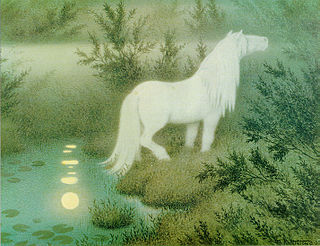
A fantasy world or fictional world is a world created for fictional media, such as literature, film or games. Typical fantasy worlds feature magical abilities. Some worlds may be a parallel world connected to Earth via magical portals or items ; an imaginary universe hidden within ours ; a fictional Earth set in the remote past or future ; an alternative version of our History ; or an entirely independent world set in another part of the universe.
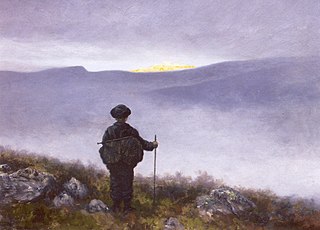
A quest is a journey toward a specific mission or a goal. It serves as a plot device in mythology and fiction: a difficult journey towards a goal, often symbolic or allegorical. Tales of quests figure prominently in the folklore of every nation and ethnic culture. In literature, the object of a quest requires great exertion on the part of the hero, who must overcome many obstacles, typically including much travel. The aspect of travel allows the storyteller to showcase exotic locations and cultures. The object of a quest may also have supernatural properties, often leading the protagonist into other worlds and dimensions. The moral of a quest tale often centers on the changed character of the hero.

Arabic epic literature encompasses epic poetry and epic fantasy in Arabic literature. Virtually all societies have developed folk tales encompassing tales of heroes. Although many of these are legends, many are based on real events and historical figures.

Historical fantasy is a category of fantasy and genre of historical fiction that incorporates fantastic elements into a more "realistic" narrative. There is much crossover with other subgenres of fantasy; those classed as Arthurian, Celtic, or Dark Ages could just as easily be placed in historical fantasy. Stories fitting this classification generally take place prior to the 20th century.

Fantasy literature is literature set in an imaginary universe, often but not always without any locations, events, or people from the real world. Magic, the supernatural and magical creatures are common in many of these imaginary worlds. Fantasy literature may be directed at both children and adults.

A Fantasy trope is a specific type of literary tropes that occurs in fantasy fiction. Worldbuilding, plot, and characterization have many common conventions, many of them having ultimately originated in myth and folklore. J. R. R. Tolkien's legendarium for example, was inspired from a variety of different sources including Germanic, Finnish, Greek, Celtic and Slavic myths. Literary fantasy works operate using these tropes, while others use them in a revisionist manner, making the tropes over for various reasons such as for comic effect, and to create something fresh.

Tanith Lee was a British science fiction and fantasy writer. She wrote more than 90 novels and 300 short stories, and was the winner of multiple World Fantasy Society Derleth Awards, the World Fantasy Lifetime Achievement Award and the Bram Stoker Award for Lifetime Achievement in Horror. She also wrote a children's picture book, and many poems. She wrote two episodes of the BBC science fiction series Blake's 7. She was the first woman to win the British Fantasy Award best novel award, for her book Death's Master (1980).

As a literary genre, the chivalric romance is a type of prose and verse narrative that was popular in the noble courts of high medieval and early modern Europe. They were fantastic stories about marvel-filled adventures, often of a chivalric knight-errant portrayed as having heroic qualities, who goes on a quest. It developed further from the epics as time went on; in particular, "the emphasis on love and courtly manners distinguishes it from the chanson de geste and other kinds of epic, in which masculine military heroism predominates."

Elements of the supernatural and the fantastic were an element of literature from its beginning. The modern genre is distinguished from tales and folklore which contain fantastic elements, first by the acknowledged fictitious nature of the work, and second by the naming of an author. Works in which the marvels were not necessarily believed, or only half-believed, such as the European romances of chivalry and the tales of the Arabian Nights, slowly evolved into works with such traits. Authors like George MacDonald (1824–1905) created the first explicitly fantastic works.

Islamic literature is literature written by Muslim people, influenced by an Islamic cultural perspective, or literature that portrays Islam. It can be written in any language and portray any country or region. It includes many literary forms including adabs, a non-fiction form of Islamic advice literature, and various fictional literary genres.

Mythago Wood is a fantasy novel by British writer Robert Holdstock, published in the United Kingdom in 1984. Mythago Wood is set in Herefordshire, England, in and around a stand of ancient woodland, known as Ryhope Wood. The story involves the internally estranged members of the Huxley family, particularly Stephen Huxley, and his experiences with the enigmatic forest and its magical inhabitants. The conception began as a short story written for the 1979 Milford Writer's Workshop; a novella of the same name appeared in the September 1981 edition of The Magazine of Fantasy & Science Fiction.
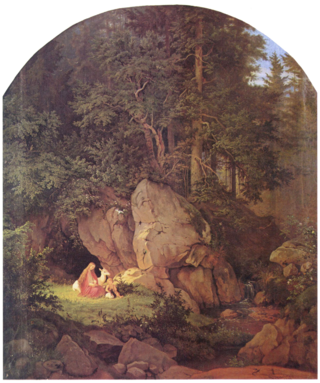
In folklore and fantasy, an enchanted forest is a forest under, or containing, enchantments. Such forests are described in the oldest folklore from regions where forests are common, and occur throughout the centuries to modern works of fantasy. They represent places unknown to the characters, and situations of liminality and transformation. The forest can feature as a place of threatening danger, or one of refuge, or a chance at adventure.

The Broken Sword is a fantasy novel by American writer Poul Anderson, originally published on 5 November 1954. It was issued in a revised edition by Ballantine Books as the twenty-fourth volume of their Ballantine Adult Fantasy series in January 1971. The original text was returned to print by Gollancz in 2002. The novel is set during the Viking Age and the story contains many references to the Norse mythology.
In analysis of works of fiction, revisionism denotes the retelling of a conventional or established narrative with significant variations which deliberately "revise" the view shown in the original work. For example, The Merry Adventures of Robin Hood revised the folklore tale of Robin Hood to depict Robin as less ambiguously heroic, influencing all subsequent modern portrayals. Many original works of fantasy appear to retell fairy tales in a revisionist manner.

Magic in fiction is the endowment of characters or objects in works of fiction or fantasy with powers that do not naturally occur in the real world.

Fantasy is a genre of speculative fiction involving magical elements, typically set in a fictional universe and usually inspired by mythology or folklore. The term "fantasy" can also be used to describe a "work of this genre", usually literary.
The multiverse is a series of parallel universes in many of the science fiction and fantasy novels and short stories written by Michael Moorcock. Central to these works is the concept of an Eternal Champion who has potentially multiple identities across multiple dimensions. The multiverse contains a legion of different versions of Earth in various times, histories, and occasionally, sizes. One example is the world in which his Elric Saga takes place. The multiplicity of places in this collection of universes include London, Melniboné, Tanelorn, the Young Kingdoms, and the Realm of Dreams.